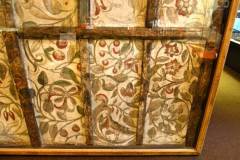Stour Street
Introduction
Since April 2019 this 12th century building has accommodated the ‘Marlowe Kit’, home of the Marlowe Theatre ‘creativity activity programme’. This includes workshops, creative classes, and activities of thee Marlowe Youth Company. Between 1987 and 2018 it was home to the Canterbury Heritage Museum. Several of the exhibits mentioned below (written before the museum closure) can now be seen Beaney House of Art and Knowledge (tel: 01227 862162). Previous uses of the building have been many and varied – a tannery, mint, hospital, goal, almshouse, poor house, and school.
History
The original building on this site was probably a tannery dating from 1174, then the residence of a wealthy minter Lambin Frese and next Adam of Charing before reverting to Lambin’s son in 1207. Stour Street was formerly called Lamb Lane, presumably in recognition of the Lambin Frese’s occupation. In 1220 Alexander of Gloucester converted it into an almshouse, later a hospital, for priests who lived communally in the hall. Later in the 13th century the hospital needed more income to support it was granted the churches of Stodmarsh and St Margaret’s Canterbury, to be followed in the 14th century by lands in the country surrounding Canterbury. In 1373 a solar and undercroft were added to the northern end of the building for the Master. Later the chapel of St Mary and a kitchen at the rear were added at right angles to the original building. In 1575 the hospital was surrendered to the crown which granted to the city, becoming variously a school, poorhouse, workhouse and clinic. In 1987 it was restored, the floor over the hall converted to a gallery, and developed to house Canterbury’s local heritage museum.
What to see:
- The view from Stour Street with from left to right the hall, solar with undercroft, and St Mary’s chapel at right angles (Image 1).
- The complicated rear elevation from the adjacent Greyfriars passage footbridge over the River Stour (Image 2).
- The stone foundations of the early house, probably of Lambin Frese, underneath a trapdoor in the kitchen area behind the chapel (Image 3).
- The dedication at the modern entrance (Image 4).
- The Saxon hall, one of the few that remain open as originally intended, from the inserted gallery (Image 5).
The Museum NB written before the museum closure in 2018
- The museum contains exhibits from pre Roman to the present as a timewalk, highlights include :
- The Canterbury cross, an AD 850 brooch found in St. George’s Street in 1867 (Image 6)
- A copy of a Saxon portable sundial found in the Cathedral cloisters in 1948 (Image 7).
- Medieval mazers (drinking vesssels), including the only extant lid (Image 8)
- A 1600 wall painting recovered form a house just outsid ethe city walls (Image 9)
- Capitals from the shrine of Saint Thomas Becket (Image 10).
- An 11th century romanesque capital with an early foliate head (or green man), originally from the cathedral (Image 11).
- The restored locomotive Invicta from the Canterbury and Whitstable Railway (Image 12).
- There are also interactive displays and galleries describing Canterbury through the ages and people with strong connections to Canterbury including Christopher Marlowe, Joseph Conrad and Mary Tourtel.
Access: For information on access ask at the Marlowe Theatre.
Sources: Lyle (2002)
SR












